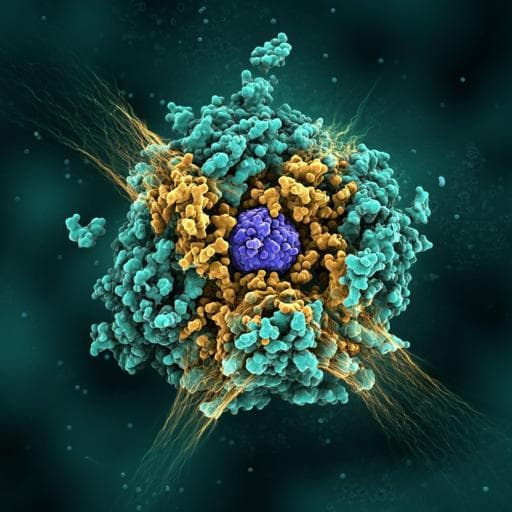
Medicine and Health
Trastuzumab deruxtecan in HER2-positive advanced gastric cancer: exploratory biomarker analysis of the randomized, phase 2 DESTINY-Gastric01 trial
K. Shitara, Y. Bang, et al.
Trastuzumab deruxtecan (T-DXd) has shown promising clinical advancements for patients with HER2+ gastric cancer, according to the DESTINY-Gastric01 trial. Engaging explorations into HER2 biomarkers and resistance mechanisms highlight correlations that could shape future therapies. This vital research was led by an exceptional team of authors.
~3 min • Beginner • English
Introduction
Trastuzumab deruxtecan (T-DXd) is an antibody-drug conjugate targeting HER2 that has shown activity across multiple tumor types, including gastric and gastroesophageal junction (GEJ) cancers. In the randomized phase 2 DESTINY-Gastric01 trial, T-DXd significantly improved ORR and overall survival versus physician’s choice chemotherapy in previously treated HER2-positive gastric/GEJ cancer (centrally confirmed IHC 3+ or IHC 2+/ISH+). Activity was also observed in exploratory HER2-low cohorts. However, gastric cancer exhibits pronounced spatial and temporal heterogeneity in HER2 expression and gene alteration, complicating patient selection. Loss of HER2 after prior HER2-directed therapies and co-occurring genomic alterations may influence response. The objective of the current exploratory analyses was to assess baseline HER2-related biomarkers in tissue and ctDNA, explore their associations with response to T-DXd, and investigate potential resistance mechanisms, including changes from baseline to end of treatment.
Literature Review
Prior work established T-DXd efficacy in HER2-positive gastric/GEJ cancer (DESTINY-Gastric01) with ORR 51% versus 14% and median OS 12.5 versus 8.4 months versus chemotherapy, leading to regulatory approvals. Exploratory HER2-low cohorts in DESTINY-Gastric01 suggested activity (confirmed ORR 26.3% in IHC 2+/ISH− and 9.5% in IHC 1+). DESTINY-Gastric02 confirmed activity in Western populations; DESTINY-Gastric04 is comparing T-DXd with paclitaxel plus ramucirumab in second line. HER2 heterogeneity is more frequent in gastric than breast cancer, and HER2 loss after trastuzumab occurs in 16–32% of patients. ctDNA profiling is widely used in gastrointestinal cancers, yet its relationship with ADC efficacy is less defined. These data motivated the present biomarker analyses to refine selection of patients likely to benefit from T-DXd and to understand resistance.
Methodology
Design: DESTINY-Gastric01 (NCT03329690) was an open-label, multicenter, randomized phase 2 trial in advanced gastric/GEJ adenocarcinoma progressing after at least two prior regimens (fluoropyrimidine, platinum, trastuzumab). Primary cohort enrolled HER2-positive tumors (IHC 3+ or IHC 2+/ISH+); patients were randomized 2:1 to T-DXd 6.4 mg/kg q3w (n=125) or treatment of physician’s choice (irinotecan or paclitaxel; n=62). Exploratory cohorts enrolled HER2-low, anti-HER2–naive patients: cohort 1 (IHC 2+/ISH−; n=20) and cohort 2 (IHC 1+; n=24), all treated with T-DXd 6.4 mg/kg q3w.
Endpoints: The original trial’s primary endpoint was ORR by independent central review; secondary endpoints included OS, duration of response, progression-free survival, confirmed ORR (≥4 weeks), and safety. This report focuses on exploratory biomarker analyses, correlating baseline biomarkers with ORR and OS, and evaluating treatment-emergent genomic changes at end of treatment (EoT).
Biomarker sampling and assays: Baseline and EoT samples were collected from the T-DXd arm in the primary cohort and from both exploratory cohorts. Tissue: Central HER2 testing by IHC (4B5, Ventana) and ISH; RNA sequencing from tumor biopsies quantified HER2 mRNA and profiled gene expression (RNA extraction with Qiagen RNeasy; library prep NEBNext Ultra II; sequencing on Illumina NovaSeq/NextSeq, 2×75 bp; alignment with STAR 2.5.3a to GRCh38; quantification by RSEM 1.3.0; voom normalization; linear modeling for differential expression). Plasma: ctDNA profiled with Guardant OMNI panel to assess ERBB2 amplification, copy number (CN), adjusted plasma copy number (apCN), other gene alterations, and blood tumor mutation burden (bTMB; 20 mut/Mb cutoff per Guardant OMNI). Samples lacking somatic mutations by OMNI were excluded from ctDNA analyses. Germline, clonal hematopoiesis, and synonymous unannotated variants were excluded; SNVs/Indels were annotated using OncoKB; low-VAF unannotated variants (≤0.2) were excluded. HER2 plasma CN was adjusted by tumor fraction (maximum variant allele fraction) per prior methods. Serum: HER2 extracellular domain (HER2ECD) measured by ADVIA Centaur HER2/neu assay.
Comparative analyses: Concordance between tissue HER2 status and ctDNA ERBB2 amplification was assessed overall and in subsets with fresh versus archival tissue. EoT ctDNA analyses evaluated acquired/lost amplifications and SNVs/Indels; McNemar tests assessed changes from baseline.
Statistics: ORR point estimates with two-sided 95% exact binomial CIs were calculated for biomarker-defined subgroups. Kaplan–Meier estimated medians with 95% CIs (Brookmeyer–Crowley). Cox models provided hazard ratios (HRs) with 95% CIs for OS. Exploratory cutoffs were pre-specified to minimize log-rank P values for OS: plasma CN 6.0; apCN 18.2; HER2ECD 14.4 ng/mL in the primary cohort; HER2 mRNA 7.7 and HER2ECD 11.6 ng/mL in exploratory cohorts.
Key Findings
Sample availability: Baseline HER2 status was available for all patients (primary n=125; exploratory n=42). Baseline ctDNA was available in most (primary n=114; exploratory n=37); fresh pre-treatment tissue for RNA-seq was limited (primary n=34; exploratory n=14).
Association of HER2 biomarkers with response (primary cohort, T-DXd arm):
- Central HER2 IHC: ORR 58.2% (95% CI 47.4–68.5; n=91) for IHC 3+ vs 28.6% (13.2–48.7; n=28) for IHC 2+/ISH+.
- Tumor HER2 mRNA (RNA-seq): High (≥median 9.72) ORR 81.2% (54.4–96.0; n=16) vs low (<9.72) ORR 23.5% (6.8–49.9; n=17).
- ctDNA ERBB2 amplification: Amp ORR 60.6% (48.3–72.0; n=71) vs no amp 34.2% (19.6–51.4; n=38).
- Plasma HER2 copy number: High (≥median) ORR 62.5% (48.5–75.1; n=76) vs low/no amp ORR 39.6% (26.5–54.0; n=53). By cutoff 6.0: high ORR 75.0% (57.7–88.9; n=56) vs low/no amp ORR 40.8% (29.6–52.7; n=33).
- HER2 apCN: High (≥18.2) ORR 78.6% (63.2–89.7; n=42) vs low/no amp (<18.2) ORR 34.3% (23.2–46.9; n=52).
- Serum HER2ECD: High (≥median 9.72 ng/mL) ORR 59.7% (46.4–71.9; n=62) vs low (<9.72) ORR 42.9% (29.7–56.8; n=56). Using cutoff 14.4: high ORR 70.2% (56.8–81.6; n=67) vs low 30.8% (18.7–45.1; n=57).
HER2 GoF mutations: Detected in 11.0% (12/109) response-evaluable patients; ORR 58.3% (27.7–84.8; 7/12). Among IHC 3+ with HER2 GoF, ORR 87.5% (7/8), acknowledging small numbers.
HER2-low exploratory cohorts: Higher ORR with high baseline HER2ECD (≥11.6 ng/mL) 36.7% (19.9–56.1; n=30) vs 0% (0–30.8; n=10) with low HER2ECD.
Overall survival (primary cohort, T-DXd arm):
- High HER2 apCN (≥18.2) mOS 16.6 months (12.5–NA) vs low/no amp mOS 8.6 months (7.6–13.0); HR 0.41 (0.22–0.74); P=0.002.
- High serum HER2ECD (≥14.4 ng/mL) mOS 14.3 months (10.8–21.2) vs low 10.1 months (7.6–12.1); HR 0.56 (0.33–0.95); P=0.028.
- IHC 3+ vs IHC 2+/ISH+ associated with longer OS; HR 0.48 (0.28–0.81); P=0.005.
Timing of tissue collection: ORR with T-DXd was similar whether HER2 IHC tissue was collected before first trastuzumab (48.8% of 82) or after/during first trastuzumab (56.8% of 37). OS favored T-DXd over TPC in both timing groups (HR 0.76 before; HR 0.28 after/during).
Concordance tissue vs ctDNA: Positive predictive agreement between tissue HER2 status and plasma ERBB2 amplification 64%; negative predictive agreement 86%. Fresh biopsy subset showed PPA 69% and NPA 100%. Approximately 24.4% changed HER2 status between archival and fresh tissue, with 32.1% downgraded from HER2+ to HER2−.
Co-alterations and response: Baseline ctDNA showed frequent alterations in TP53 (77%), ERBB2 (51% amp), CCNE1 (28% amp), EGFR (22% amp, 10% SNVs/Indels). Amplifications in MET, EGFR, FGFR2 associated with numerically lower ORR: MET amp 25.0% (3.2–65.1; n=8), EGFR amp 32.1% (15.9–52.4; n=28), FGFR2 amp 0% (0–45.9; n=6). bTMB low/NE had ORR 55.1% (43.4–66.4; n=78) vs high bTMB ORR 41.9% (24.5–60.9; n=31). KRAS/NRAS activating variants ORR 50.0% (24.7–75.3; n=16) vs WT 51.6% (41.0–62.1; n=93). PIK3CA GoF ORR 33.3% (7.5–70.1; n=9) vs WT 53.0% (42.8–63.1; n=100).
End of treatment (EoT) genomics: ERBB2 ctDNA amplification frequency decreased from 45% (37/82) at baseline to 33% (27/82) at EoT. Three acquired TOP1 variants (E709G, L429R, D533G) were detected, suggesting potential payload-target–mediated resistance, though rare. No consistent pattern of acquired amplifications or SNVs/Indels across genes.
Gene expression: Responders had higher expression of 57 genes, notably those co-amplified on chromosome 17q12–21 including HER2; PD-L1 RNA level showed no clear association with T-DXd efficacy.
Discussion
These exploratory analyses demonstrate that multiple HER2-associated biomarkers in tissue, plasma, and serum correlate with T-DXd activity and survival in previously treated HER2-positive gastric/GEJ cancer, and suggest signal in HER2-low disease. Higher HER2 IHC staining, tumor HER2 mRNA expression, ctDNA ERBB2 amplification/apCN, and serum HER2ECD were consistently associated with higher ORR and, for several measures, longer OS. While ctDNA ERBB2 amplification showed only moderate positive predictive agreement with tissue HER2 status, the high negative predictive agreement supports potential utility when tissue is unavailable; discordance may reflect tumor heterogeneity, assay limitations, or metastatic site effects on ctDNA shedding. Co-alterations in MET, EGFR, and FGFR2 were associated with numerically lower response, but small subgroup sizes and lack of a randomized biomarker-controlled comparison preclude definitive conclusions regarding predictive versus prognostic effects. The observed reduction of ERBB2 amplification at EoT and rare acquired TOP1 mutations point to heterogeneous and potentially payload-target–related resistance mechanisms; patients maintaining HER2 positivity but acquiring TOP1 alterations might benefit from HER2 ADCs with alternative payloads. Clinically meaningful activity was observed irrespective of whether HER2 testing occurred before or after/during initial trastuzumab, suggesting that in later-line settings, baseline HER2 status remains informative despite prior HER2 therapy and potential temporal heterogeneity. Overall, integrating tissue and liquid biopsy biomarkers may refine patient selection for T-DXd, but prospective validation is required.
Conclusion
In DESTINY-Gastric01 exploratory biomarker analyses, higher levels of HER2-associated biomarkers in tissue (IHC/ISH, mRNA), ctDNA (ERBB2 amplification, apCN), and serum (HER2ECD) correlated with greater T-DXd activity and, in several analyses, improved survival. T-DXd showed activity even in HER2-low disease, particularly among patients with higher HER2ECD. Co-amplifications in MET, EGFR, and FGFR2 trended toward lower response rates, and rare acquired TOP1 mutations at progression suggest potential payload-target resistance. These findings support the potential role of ctDNA and serum biomarkers to complement tissue HER2 assessment for selecting patients for T-DXd. Future research should prospectively validate biomarker cutoffs, clarify the predictive versus prognostic nature of co-alterations, investigate mechanisms of resistance (including TOP1 variants), and assess the utility of serial ctDNA/serum monitoring across ongoing studies such as DESTINY-Gastric02/03/04 and EPOC2203.
Limitations
Analyses were exploratory/post hoc with limited sample sizes and without external validation. Many subgroup comparisons lacked a concurrent control arm, limiting assessment of predictive versus prognostic effects. Multiple testing corrections were not performed for several analyses. Fresh pre-treatment tissue was available in a subset only, and tissue–plasma discordance may reflect tumor heterogeneity and technical limitations. ctDNA analyses excluded samples without detectable somatic variants, potentially introducing selection bias. Findings and exploratory cutoffs require prospective validation.
Related Publications
Explore these studies to deepen your understanding of the subject.







